Juli 2021
LEA-X5: New Movie on the completion of the European 5m X-band LDRS
Gladly we announce with a new 20-minutes-movie the completion of the H2020-development „LEA-X5“, the 5m class European Large Deployable Reflector Subsystem (LDRS) operating in X-band.
The film itself is of course showing recent environmental and deployment tests, but it is mainly about PEOPLE, who are space engineers and space enthusiasts, and what they can achieve with combined powers and brains. These people, together with the enablers European Commission and European Space Agency, are making the achievement of „European Non-dependance“ happen.
LEA-X5 is a full LDRS-Subsystem (lead by HPS, Germany) and comprises the
- 5m diameter X-band reflector assembly (lead by LSS, Germany)
- the 5m long deployable arm assembly (lead by HPS, Germany),
- hinges & HDRMs (RUAG, DE),
- deployment electronics (vH&S, DE),
- thermal hardware (HPS/FHP).
Further partners of the H2020-consortium have been: INVENT (DE), FHP (PT), INEGI (PT), TICRA (DK), LUMA (SW), HPTEX (DE), ARQUIMEA(SP), HPS (RO), ETAMAX (DE), WSS (DE), ONERA (FR), TAS (FR), OHB (DE), Airbus (DE).
Most of the consortium members are introduced in the movie, inluding many interviews.
Take your time and enjoy the spirit of doing big things: LEA-X5 – European 5m X-band LDRS Completed (Final Report 06/2021) – YouTube
Best regards,
Your WeLEA-Consortium
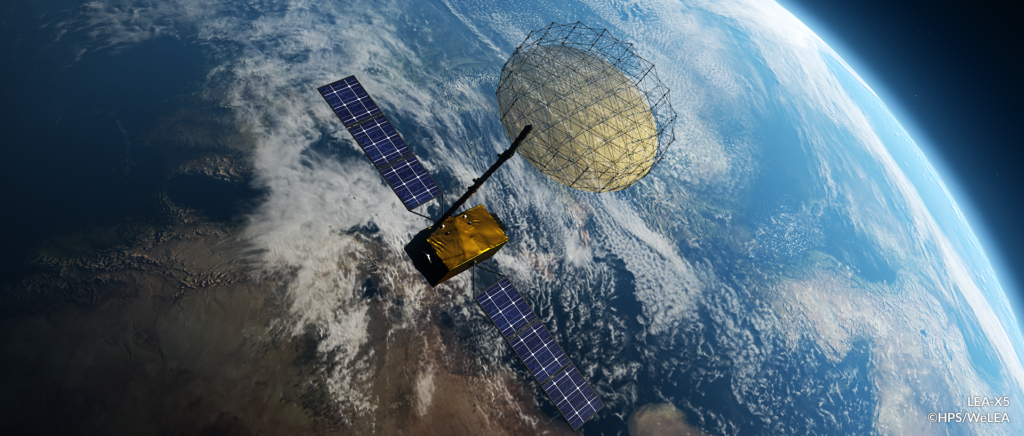
March 2021
Europe´s innovative deployable antenna technology takes the next hurdle
With the successful test of the Deployable Assembly Arm (DAA), which connects a Deployable Reflector Assembly (DRA) to the satellite, just completed at INEGI, the European LEA consortium led by HPS has cleared the next hurdle in the technical realization of Europe’s new antenna technology.
The 5m long DAA consists of 3 hinge mechanisms and 2 HDRMs (both by RUAG Space Germany), Release Mechanisms (by Arquimea, Spain), three CFRP tube segments (by INVENT, Germany), Metal Fittings (partly by HPS Romania), Deployment Control Electronics & EGSE (by von Hoerner & Sulger). Focus of the tests have been the verification of a) the functional full deployment (which takes in total 25 min.), b) a high pointing accuracy of the arm and c) the verification of the mathematical thermo-elastic models.
INEGI (Portugal) is the main partner for the arm deployment test and a good partner of HPS for over 13 years now. INEGI was responsible for the 0-g-simulation Test Stand and the Thermo-elastic Distortion Test Stand. Despite the pandemic and all restrictions the teams could manage this progress with highest motivation and closest possible contact between the INEGI/HPS team on-site in Porto and the HPS-engineers in Germany. HPS is responsible for the DAA and also for the implementation management of the whole LEA-activity. The total LEA-team encompasses 15 partners from 7 countries; the program started in the framework of H2020 in November 2017. The arm deployment test and the TED-test (thermo-elastic distortion) was one of the last tests of this H2020 activity.
The next step – starting still in March – is the environmental test (vibration and thermal vacuum) of the full LDR-Subsystem (Reflector, Arm and HDRM, all connected), which will be performed at INTA in Madrid, Spain.
“LEA-X5” (5m reflector diameter, 5m arm length, X-band application for Earth Observation and Telecommunications) is meanwhile seen as one of the precursing technology developments for the current Copernicus CIMR Mission.

March 2021
Arm and Reflector of LEA-X5 Successfully Mated to Form Complete Subsystem
Fifteen companies – mostly SMEs – from seven countries and one goal: a deployable 5-meter X-band-antenna as a preliminary development for the CIMR project, developed under the European H2020 program (2017-2021). For the first time ever, such a complete subsystem (HPS) has now been successfully assembled in Europe from the reflector- (LSS) and arm- (HPS) assemblies. Previously, the test deployment of the arm and reflector – each individually – had already been successfully passed.
LEA-X5-Subsystem is now at the premises of the consortium´s highly reliable test partner INTA in Spain, where vibration tests for the subsystem are on the agenda in the presence of the LSS- and HPS-teams. In a third round of testing, the subsystem will have to prove itself capable of withstanding the conditions of the thermal chamber.
The next complete subsystem-hardware in this context – the CIMR LDRS-EQM – will be assembled end 2023.
With the key technology behind LEA-X5, the continent is decisively expanding its independence from non-European sources.
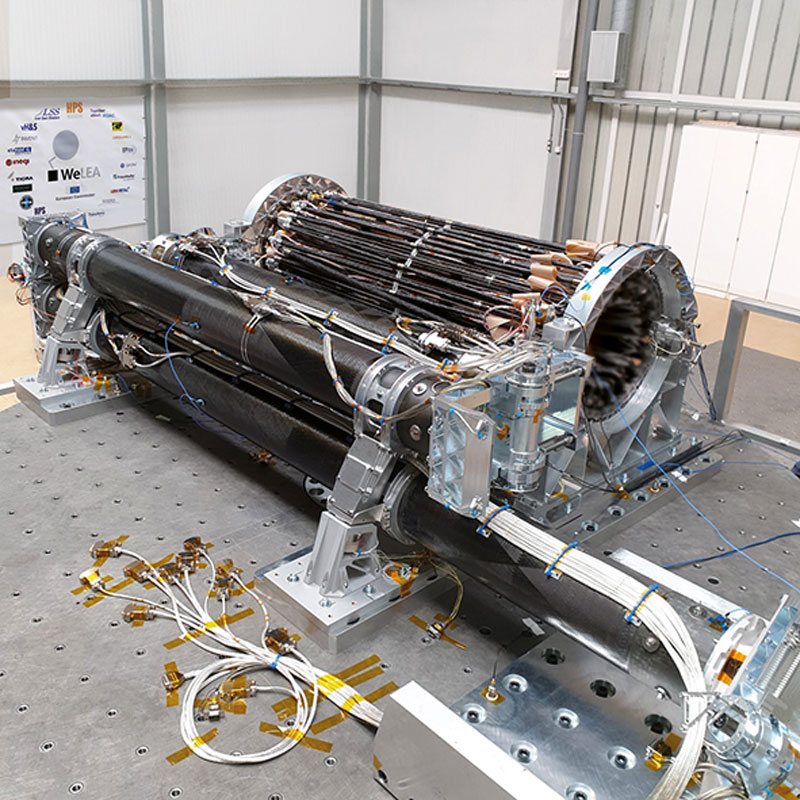
October 2017
Authored by the HPS – the „M“ in European Space SME
„Technology“ means „knowledge how to solve problems by applying technical solutions“. In the absence of abundant natural resources technology is nothing less than the key to self‐determination and liberty as the highest societal value in a free world.
Therefore, the European Commission (EC) dedicates with high priority comprehensive programs to …“
More information can be found in the LEA_Press_Release_1 and in the article of Space Intel Report
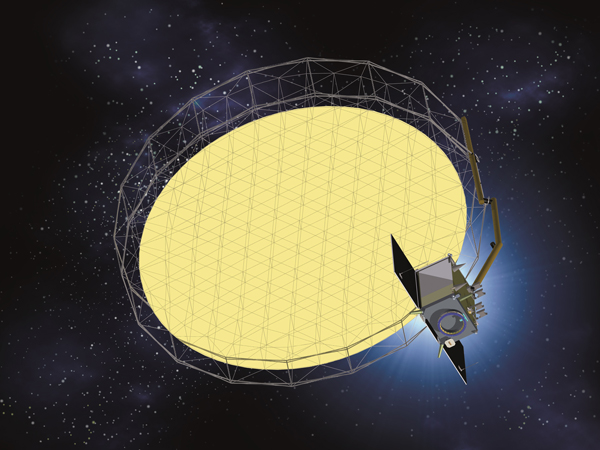
HPS announcing crucial milestone set for Europe´s own large deployable reflector subsystem (LDRS)
April 2019
Large deployable antenna reflectors are among the critical space technologies most urgently needed in Europe in order to drastically reduce the continent´s dependence on goodwill, knowhow, and supplies from the United States. Therefore, back in fall 2017 the EC decided to co-fund in the fame of its Horizon 2020-programm the 7 million € development-project LEA (Large European Antenna) of a consortium with 15 partners out of six European (D, SP, PT, SE, DK, FR) countries under the implementation leadership of HPS, Germany, among them also LSS GmbH (Germany) and RUAG Space Germany. A special cooperation between HPS and Northern Bavarian entities has already led to the development of the central component, the „European Space Mesh“; it will in future be produced in Bavaria. Now the project has taken its crucial milestone when it passed the Critical Design Review (CDR) in April 11-12, 2019, and is heading towards the final stage of its test campaign from February through August 2020. In exchange for the opportunity to gain flight heritage HPS offers the first product, LEA, for free to any customer worldwide.
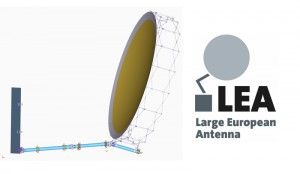
Major specs of LEA are: deployable reflector aperture at 5.1 meters with a 5.6 meter long deployable arm; a mass of just 100 kilo including reflector, arm, hold-down-and-release-mechanism, harness, thermal hardware, operating frequency: X-band. The stowed volume is as small as 2.6 x 1.2 x 0.6 meters.
This development is not only important in general, but serves also as a baseline for two potentially next Copernicus missions at the horizon with 8 and 12 meter reflector subsystems. The whole development program of LEA is based on precursors undertaken within the framework of ESA technology programs.
For more information on LEA please klick: www.welea.eu.
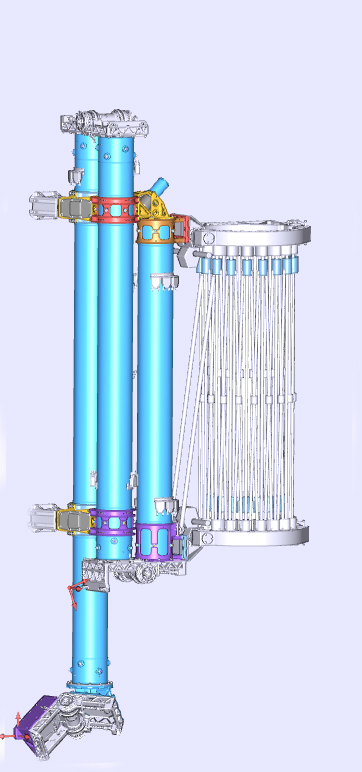
Second step taken towards European technological independence regarding large deployable reflectors
May 2019
HPS-consortium wins ESA´s LEOB challenge
The European consortium of 17 partners out of six European countries initiated and led by HPS GmbH has won the prestigious ESA contract for LEOB, the Large European Reflector for Earth Observation. The call had been initiated by ESA´s Earth Observation directorate in 2018.
The HPS consortium, including LSS Germany and RUAG Space Germany, won against severe competition from Italy, Spain, and the U.K.. Total budget amounts to 5 million €; taken together with contract number one on the development of a large deployable reflector out of late 2017, the budget to develop this critical technology now amounts to 12.5 million €. Future mission targets include geological changes, monitoring of vegetation, communications, Big Data, Internet of Things, and sciences.
Kick-off was on April 15th, 2019, the project will conclude with a tested Engineering Model exactly two years later in April 2021. It is the last precursor project before the development of a flight model for two future Copernicus missions: CIMR with a 7-8m reflector, operating in L- through Ka-band, rotating on top of the satellite at a speed of ten turns per minute, and ROSE-L with 12 meters of diameter, operating in L-band.
Precursing ESA-technology programs and LEA out of Horizon 2020 had laid the foundations for this great success.
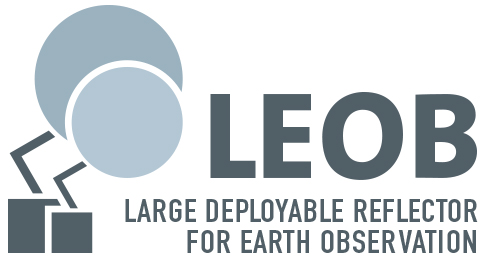
October 2019
A European Declaration of Non-dependence in Space
Dear Friends and Fans of Europe in Space,
in the name of all members of our pan-European WeLEA-consortium we proudly present a video, documenting the successful road of the development of one of the most needed critical technologies in space: the Deployable Large European Antenna (LEA).
Invented, designed, tested and manufactured by more than 15 well known space companies from 7 European countries with a total staff of more than 500 dedicated specialists, representing a truly unique team of SMEs and Midcaps, the LEA-product is now taking shape as nothing less than “A European Declaration of Non-dependence in Space”.
Thanks to the farsighted vision of both powerful institutions responsible for our continent´s future in space, the European Space Agency ESA and the European Commission EC, LEA will become an invaluable technological asset to blaze our own trail towards knowledge and understanding as indispensable prerequisites to making this world a sustainable, better place – for life in diversity, for all citizens on the globe, and for one Europe across all its internal borders.
Within the WeLEA consortium HPS Germany, as prime contractor, is responsible for the project- and technical management of the whole LEA-subsystem, the deployable arm assembly and the reflective metal mesh.

Noveber 2020
Deployable 5-meter “LEA” antenna starts baptism of fire on the test stand
Punctually three years after the decision of the EU, in November 2017, to place the development of the critical space technology of an antenna that can be deployed in space in the hands of an SME-consortium with 15 companies from seven member states led by the Munich-based antenna specialist HPS, the project celebrated four successful European premieres on November 10th 2020:
- Installation of a 5m deployable reflector of and by LSS GmbH
- First surface accuracy check of this reflector
- First RF (Radio-Frequency) test of the complete reflector
- First successful application of highly innovative RF-test technology.
The space programs of ESA and the EU reflect the enormous importance of research and application projects from earth observation and telecommunications for the development of independent ecological and economic positions in politics and business.
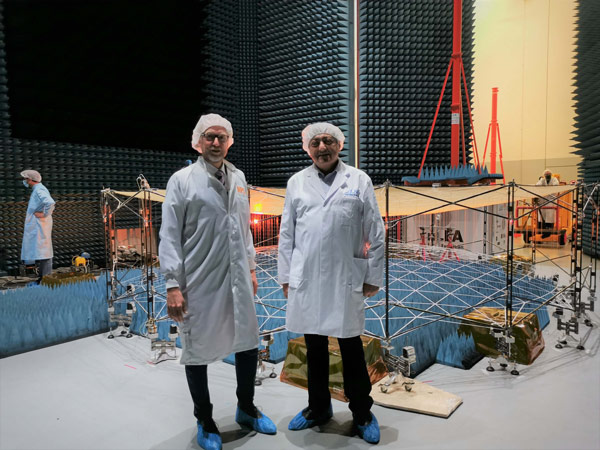
The first prerequisite for this is the unrestricted availability of the communication capabilities and image data collection of corresponding satellites – and thus of their antennas. In order to save weight and storage, more and more deployable constructions are being planned here, which have so far only been available in the USA. Europe has now put a stop to this dependence.
The 5-meter antenna (now under test) under the designation “LEA-X5”, is intended for X-band communication. The surface accuracy of the reflector, developed since the beginning and assembled now by LSS for many months, was measured by HPS with laser radar technology from NIKON. The element of the antenna responsible for the reflection, the gold plated metal mesh under the designation “ESM-European Space MESH”, is also compatible with the higher Ku-band. It is manufactured by HPTEX, a joint venture of HPS and Iprotex in cooperation with Fraunhofer in Münchberg. The high-precision carbon fiber struts were developed by the Portuguese company “FHP”, while unfolding electronics were supplied by the Schwetzingen Company “von Hoerner & Sulger”.
Also the adherence to all interlinked corridors of the participants all over Europe to realize this early test date was successful despite considerable organizational complications caused by the Covid-19 pandemic: “operative flexibility in teamworking, technical genius and the unconditional will to succeed – these are the decisive factors especially in these times. And the WeLEA example shows once again: These are medium-sized companies,” says HPS CEO Pfeiffer. And the CEO of LSS, Leri Datashvili adds: “it has been a very hard work of the LSS team after having collected all the needed components and materials from partners to have designed and built a 5 m large deployable reflector in a very short time reaching the high quality of the RF surface shape, which is now ready for the RF tests”
Now the reflector will be characterized in several frequency ranges (C to Ka-Band) from Airbus over the next 3 weeks in Ottobrunn. Special ground support mechanisms from the Portuguese company INEGI ensure that the reflector is positioned horizontally. The prediction of the antenna performance was carried out by the Danish company TICRA with the help of their special RF software GRASP, with geometrical data from LSS simulations.
In the next step, not only the reflector, also the deployable arm of the antenna will be tested environmentally at INTA in Spain; the focus will be on compliance with vibration, shock and thermal vacuum requirements. Beginning next year intensive deployment tests will follow finally. The entire test campaign will be concluded with PFM (proto-flight model) status in March 2021.
In parallel, WeLEA is already working on an 8-meter Ka-band capable engineering model “LEA-K8r” (reflector and arm) in contract to ESA, as preparation for the technical realization of the polar cap mission CIMR (Copernicus Imaging Microwave Radiometer), which will help Europe to gain its own and politically unbiased picture of the status of climate change. The first deployment tests are planned here for the first quarter 2021.
About WeLEA:
The European SME dominated „WeLEA“-SME-consortium consists of the following European space companies: HPS (prime contractor, DE), LSS (main partner for the reflector, DE), RUAG (DE), FHP (PT), vH&S (DE), Luma (SE), Invent (DE), HPtex (DE), ARQUIMEA (SP), etamax (DE), TICRA (DK), WSS (DE), Inegi (PT), INTA (SP), ONERA (FR). The consortium is strengthened in the H2020-LEA-X5 project on system- and test-side by OHB (DE), TAS (FR) and Airbus (DE).
December 2020
ESA and Thales Alenia Space Italy (TAS-I) authorize HPS to develop the large deployable reflector subsystem “LEA” for the Copernicus mission CIMR
It is official today, 02.12.2020: Europe is going to develop a new independent technology in the European space sector. Thales Alenia Space Italy has been selected by ESA and the European Commission as the Satellite Prime for the Copernicus mission CIMR contract. At the same time, HPS Germany, as leader of an SME-oriented consortium of 15 companies from seven countries (main partners are LSS, vonHoerner&Sulger and RUAG), were selected to develop the “Large Deployable Reflector Subsystem” (LDRS) called “LEA-K8r”. This large, 8-meter diameter reflector will be deployed in space and rotates about a non-symmetrical axis: a world first! Today, with this contract signature, HPS and the European consortium have been authorized to start the development with the phases B2/C/D.
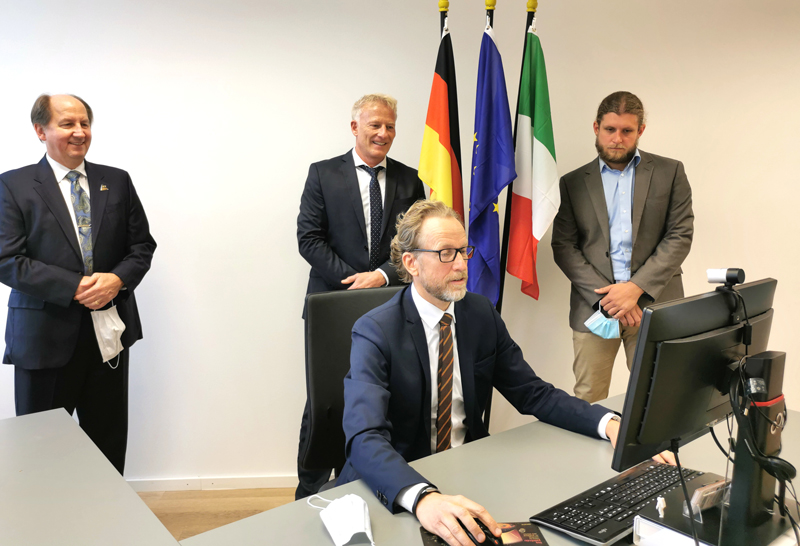
The CIMR-mission, in the context of the Copernicus Earth Observation Programs of the European Commission, provides a significant contribution to the „Integrated European Policy for the Arctic“, whose objective is an improved understanding of the effects of climate change, especially in the Arctic region, and thus will establish key requirements for the Arctic communities. The CIMR-mission will provide improved continuity (sub-daily) in the monitoring of floating sea ice in terms of spatial and temporal resolution. In addition, the instruments will provide global coverage of sea surface temperature measurements, but with a specific focus on the Polar Regions.
Authorized was now the first tranche with 23.0 MioEuro for Phase B2, with an HPS-share of 7.1 MioEuro for two years. In total, the Phase B2/C/D/FM2 contract amounts to 110 Mio Euro until the PFM Satellite launches in 2027 and until the delivery of the FM2 LEA-reflector-subsystems in 2028. The share of HPS Germany values to 26 Mio Euro, which results in an average of 3.2 MioEuro per year, and which assures 15-20 high quality jobs.
HPS CEO Ernst K. Pfeiffer commented: “We are all very pleased to be able to make an active contribution to European non-dependence in an area of critical technology as a subcontractor to TAS-I, and to be able to assume global technology leadership with the innovation of an unprecedented rotating 8m Ka-band reflector subsystem in our portfolio. On behalf of the WeLEA-consortium, I would like to thank all those in Germany and throughout Europe who have supported our ten-year journey to this strategically, politically and technically magnificent position.”
The first phase, B2, includes the detailed design of an EQM. Central to this effort is an intensive breadboard test program, which will raise the few remaining critical elements of LEA to Technology Readiness Level (TRL) 5 within 6 months. As an example, a Ka-band mesh, the “European Space Mesh”, is being developed and produced by the new HPS/IPROTEX joint-venture “HPTEX” along with cooperation from Frauenhofer ISC, in Upper Franconia. Since this metal mesh needs to have an optimal design with respect to electromagnetic wave reflection and mechanical stretch parameters, intensive parameter studies are currently being undertaken. Promising initial results have already been achieved in pre-development.
And our next goals are already in sight: Hydroterra, ESA’s EE10 Candidate Mission which requires a deployable reflector of at least 7 meters in diameter; SENTINEL-1 NG Mission, requiring a single large reflector; and a Ka-Band Internet Broadband mission with 5-metre reflectors.
In addition to large deployable reflector subsystems, the main product lines of the HPS portfolio are classic 1-2 meter reflector antennas for science missions (e.g. Euclid & HERA) and telecommunication missions (e.g. Heinrich Hertz), as well as the world’s only operational product series of serially-manufactured satellite-de-orbit systems under the brand name “ADEO” for decommissioned satellites. By the end of 2021, the HPS Group, consisting of HPS Germany, HPS Romania and HPtex, will grow at least up to 100 employees.
